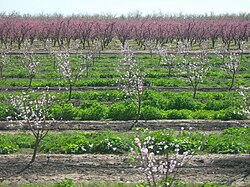Almond
The almond, Prunus dulcis, is a small tree in the family Rosaceae. "Almond" is also the name of the edible and widely cultivated 'nut' of this tree.
| Prunus dulcis | |
|---|---|

| |
| Almond flowers | |
| Scientific classification | |
| Kingdom: | |
| Division: | |
| Class: | |
| Order: | |
| Family: | |
| Subfamily: | |
| Genus: | |
| Species: | P. dulcis
|
| Binomial name | |
| Prunus dulcis | |
Native to Iran and bordering regions, almonds are also grown in places with Mediterranean climates.[1]
The fruit of the almond has an outer hull and a hard shell with the seed or nut inside.[2] Shelling almonds means removing the shell to get the seed. Almonds are sold either shelled or unshelled.
Description
The almond tree is about four to 10 meters tall. It has a trunk about 30 centimetres wide. The young twigs are green at first. When they are in their second year, they turn gray. The leaves are three to five inches long.[3] The flowers are white or light pink, 3–5 cm wide with five petals.[4][5]
Almond Media
Almond tree with blossoming flowers, Valley of Elah, Israel
Amandines de Provence, poster by Leonetto Cappiello, 1900, which shows a woman eating almond biscuits (almond cookies)
Related pages
- Amygdalodon (almond teeth)
- Almond flour
- Almond butter
- Almond milk
References
- ↑ "Prunus dulcis - an overview | ScienceDirect Topics". www.sciencedirect.com. Retrieved 2021-06-27.
- ↑ The almond we eat is the edible seed of a type of fruit called a "drupe".
- ↑ Bailey L.H.; Bailey, E.Z.; the staff of the Liberty Hyde Bailey Hortorium. 1976. Hortus third: A concise dictionary of plants cultivated in the United States and Canada. Macmillan, New York.
- ↑ Rushforth, Keith (1999). Collins wildlife trust guide trees: a photographic guide to the trees of Britain and Europe. London: Harper Collins. ISBN 0-00-220013-9.
- ↑ Griffiths, Mark D.; Anthony Julian Huxley (1992). The New Royal Horticultural Society dictionary of gardening. London: Macmillan Press. ISBN 0-333-47494-5.
Other websites
| Wikimedia Commons has media related to Lua error in Module:Commons_link at line 62: attempt to index field 'wikibase' (a nil value).. |










